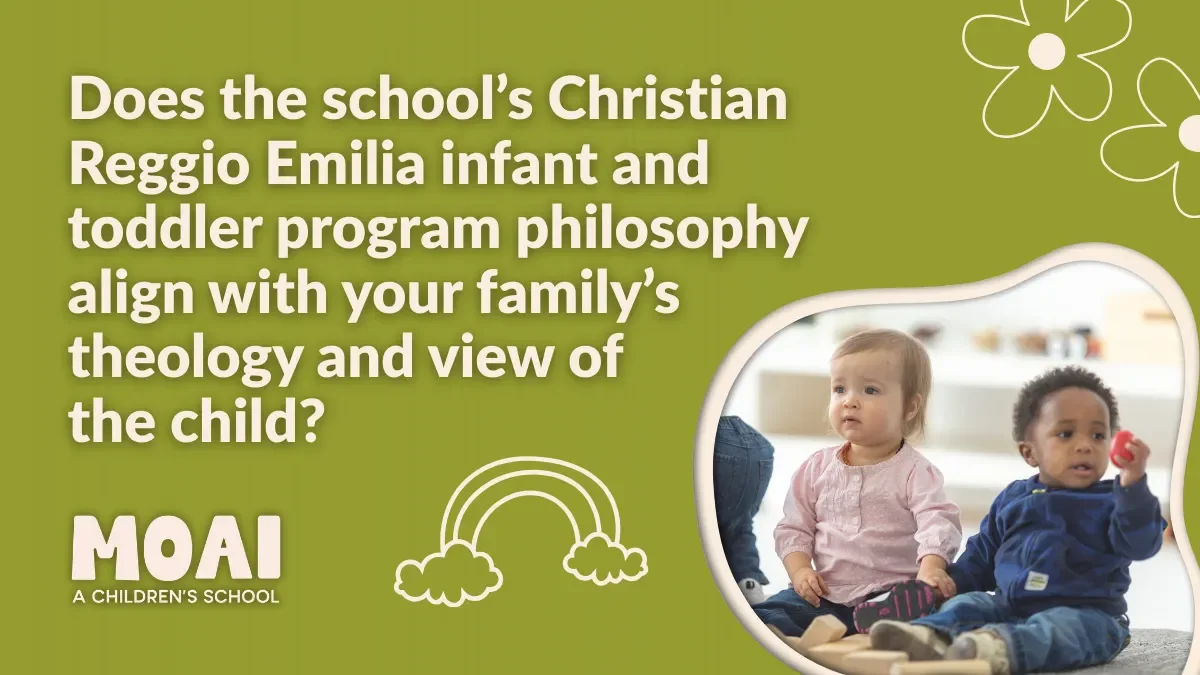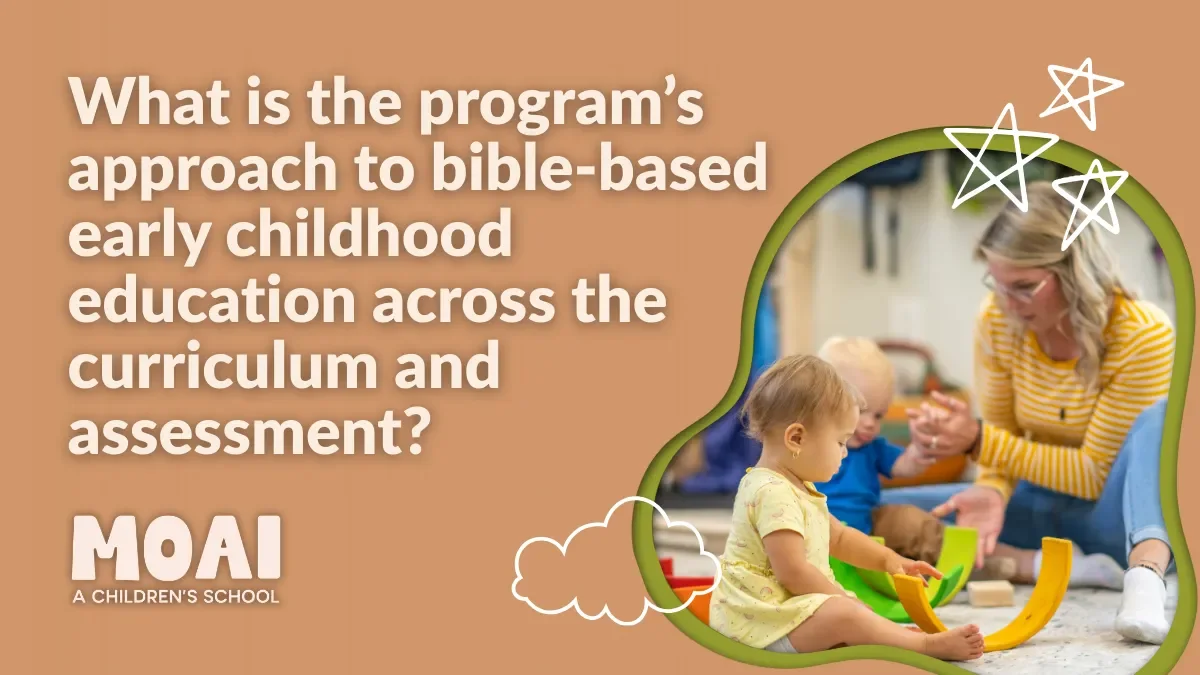7 Questions Christian Parents Should Ask When Choosing a Faith-Based Infant & Toddler Center
Selecting Christian infant and toddler care near Fremont, Seattle requires careful consideration of faith alignment, safety, and early learning quality. The right program will support biblical worldview formation while delivering developmentally appropriate caregiving and social-emotional growth. To make a confident choice, parents should evaluate how Scripture informs daily care routines, how teachers model Christ-like character, and how curriculum integrates sensory exploration, play, and early language.
It is essential to review caregiver qualifications, infant and toddler ratios, safe sleep and security protocols, and communication practices with families. The following seven questions provide a structured framework for comparing programs and identifying a setting that nurtures both heart and mind.
1. Does the school’s Christian Reggio Emilia infant and toddler program philosophy align with your family’s theology and view of the child?
A Christian Reggio Emilia infant and toddler program should reflect your family’s theology and a high view of children as competent and capable image-bearers. Confirm that the “image of the child” statement acknowledges dignity, curiosity, and responsibility before God. The teacher–caregiver’s role should combine co-researcher and discipler, guiding inquiry and co-regulation while modeling Christ-like character and language.
Integration of faith within inquiry is essential. Review how scripture informs invitations to explore, caregiving routines, and classroom rituals. Look for prayer woven into transitions, Bible memory embedded in language work, and worshipful reflection during shared exploration moments. Creation care, service, and empathy can frame science, community, and social-emotional learning investigations.
Environment and documentation should make learning and faith visible. Classrooms should function as a “third teacher,” with natural, sensory-rich materials, open-ended tools, and accessible Bibles or verse cards. Documentation panels should connect learning stories to faith goals and developmental benchmarks, supported by portfolios that track growth.
Verification points:
Written statement of faith and pedagogical framework
Daily schedule showing prayer, scripture, and worship rhythms
Sample project that integrates biblical themes with academic domains
Rubrics for assessment and family conferences
Professional development in Reggio practices and spiritual formation
Alignment across these elements indicates coherence between philosophy, practice, and your family’s convictions.
2. How does this faith-based infant and toddler program in Seattle integrate Scripture and worship into the daily schedule?
A faith-based infant and toddler program in Seattle should demonstrate a consistent, age-appropriate rhythm of Scripture and worship woven through the day. Brief morning circle or caregiving moments can set the tone with prayer, a short Bible reading, and a simple song that anchors the class theme. Short verses or key phrases should connect to character formation—kindness, gratitude, courage—and be reinforced with gestures, visuals, and repetition suited to toddlers and older infants.
Integration continues across care routines and transitions. Bible narratives can inform sensory play and simple storytelling; songs can accompany clean-up and outdoor transitions; and reflection prompts can follow shared exploration to connect discoveries with biblical truths. Brief, child-centered worship moments—three to eight minutes—may include a call-and-response, a single focus verse, and a closing blessing. Teachers model reverence through posture, language, and gentle redirection, fostering a calm, worshipful atmosphere.
Partnership with families strengthens continuity. Weekly notes can preview verses and songs, suggest at-home prayers, and invite families to share simple stories of kindness or service. Seasonal rhythms (e.g., creation care weeks, gratitude month) provide coherence without overwhelming young learners.
Verification points:
Daily schedule showing prayer, Scripture reading, songs, and reflection moments
Scope and sequence for Bible stories and verses aligned to development
Sample worship moment or chapel plan with duration, roles, and behavior supports
Classroom and caregiving prompts linking projects to faith themes
Family communication outlining at-home reinforcement and participation opportunities
3. What is the program’s approach to bible-based early childhood education across the curriculum and assessment?
A bible-based early childhood education should integrate Scripture, Christian character formation, and developmentally appropriate practice across all infant and toddler learning domains. The approach anchors a clear scope and sequence of simple Bible narratives and virtues while aligning instructional goals with state early learning standards. Teachers function as co-researchers and disciplers, linking shared explorations and caregiving routines to biblical themes and modeling Christ-like habits of heart and mind.
Curriculum integration should be concrete and age-appropriate. Language and literacy can include short memory phrases, shared reading of board-book Bibles, and story retelling with puppets or story stones. Mathematics may explore patterns, counting, and stewardship through care routines, helping tasks, and daily rhythms. Science and nature study can frame creation care through sensory exploration, gentle observation, and wonder questions. Social-emotional learning should emphasize the fruit of the Spirit, peacemaking, gratitude, and service. Visual arts and music can draw from psalms, hymns, and responsive art connected to weekly themes.
Assessment should make both learning and faith formation visible. Teachers gather evidence through observation notes, photographs, and brief captions capturing gestures and emerging words. Portfolios include work samples, developmental checklists, and simple reflections linked to verses or virtues, alongside daily care logs. Family conferences review progress, set goals, and outline supports or extensions.
Verification points:
Written scope and sequence mapping of Bible stories to domains
Weekly plan showing integrated care routines and exploration prompts
Portfolio template with documentation guidelines
Assessment rubrics aligned to developmental benchmarks
Family conference schedule and sample progress report
4. How are health, safety, and behavior supported throughout the day?
Health practices begin with clear ratios, active supervision, and staff who hold current CPR/First Aid certifications and background checks. Classrooms follow illness exclusion criteria, handwashing protocols, and surface sanitization schedules aligned with licensing guidance. Allergy management includes posted care plans, safe bottle and snack procedures, and trained response for EpiPen use. Medication administration is documented with parent authorization, and steps are double-checked. Safe sleep and diapering/toilet learning routines follow hygienic, developmentally appropriate procedures with privacy and dignity, including back-to-sleep positioning, empty cribs, and individualized sleep plans. Outdoor spaces are inspected daily, and sun and weather policies are applied consistently.
Safety is maintained through secure entry, controlled visitor access, and verified sign-in/out with authorized pick-up lists. Rooms are arranged for visibility, with hazard checks and emergency supplies on hand. Staff conduct regular fire, earthquake, and lockdown drills using concise scripts and calm redirection. Incident reporting is prompt, with root-cause review informing future prevention.
Behavior support is proactive and relational. Teachers establish predictable routines, visual cues, and clear expectations. Emotion-coaching, co-regulation strategies, and simple problem-solving language guide early conflict resolution. Sensory tools and quiet spaces assist self-regulation, with individualized support plans developed in partnership with families and, when needed, specialists.
Verification points:
Written health policies, safe sleep guidelines, allergy plans, and medication forms
Staff credentials, background checks, and CPR/First Aid records
Daily sanitization logs, crib/sleep check logs, and playground inspection checklists
Emergency procedures, drill schedule, and incident reports
Behavior guidance framework (including co-regulation) and sample individualized support plan
5. What are the qualifications and formation of teachers and staff?
Teachers and caregivers should hold relevant credentials in early childhood education or closely related fields, supported by state-required training, verified background checks, and current CPR/First Aid certifications. Look for demonstrated experience with inquiry-driven or Reggio-inspired practice, skill in documentation, and proficiency in age-appropriate assessment for infants and toddlers, including responsive caregiving, safe sleep, and health and sanitation protocols. Assistants and floaters should receive structured onboarding covering supervision, health and safety, and classroom support to ensure daily continuity across feeding, sleep, and diapering routines.
Formation should address both professional growth and spiritual maturity. Schools can provide a coaching cycle with observation, feedback, goal-setting, collaborative planning for projects and centers, and training in child development, behavior guidance, trauma-informed care, and inclusion. Spiritual formation may include shared devotions, reflection on Scripture, and alignment with a clear statement of faith, emphasizing Christ-like communication and service. Reliable staffing plans—ratios, coverage for breaks, and a qualified substitute pool—sustain quality and protect instructional time while maintaining continuity of primary caregiving.
Evidence of a healthy culture includes low turnover, consistent mentorship, and transparent communication with families. Staff should model calm, respectful language, maintain confidentiality, and adhere to mandated reporter protocols.
Verification points:
Staff bios detailing degrees, certifications, years of experience, and infant–toddler competencies
Records of background checks, CPR/First Aid, mandated reporter training, and safe sleep certification
Professional development calendar and coaching/observation framework
Statement of faith and staff handbook outlining expectations
Coverage plan for ratios, breaks, and substitutes, with retention metrics
6. How does the school partner with families and communicate progress?
Partnership begins with respectful onboarding: a family intake meeting to understand routines, culture, and health needs; an orientation that explains schedules, faith practices, and expectations; and a concise handbook outlining policies and contacts. Staff maintain consistent, two-way communication and document agreements to support continuity between home and school, including feeding, sleep, and diapering preferences.
Ongoing updates use predictable cadences. Daily notes summarize care routines, highlights, and reminders, including bottles and meals, diapers, naps, and comfort strategies. Weekly newsletters preview learning goals, Bible stories, memory verses, and upcoming events appropriate to infants and toddlers. Photos and learning stories make progress visible while observing privacy and consent policies. Translation support and accessible formats are provided when needed. Teachers offer defined office hours and prompt responses for time-sensitive concerns.
Progress reporting combines qualitative and quantitative evidence. Portfolios include work samples, observation notes, and developmental checklists aligned to infant–toddler standards and faith formation goals, alongside daily care logs. Scheduled conferences—typically fall and spring, with optional midyear check-ins—review growth, set targets, and outline home strategies. When appropriate, referrals and coordinated plans with specialists are documented and monitored.
Verification points:
Written communication plan with daily, weekly, and conference cadences
Calendar for conferences, reports, and key events
Portfolio templates and sample narrative progress reports, including daily care logs
Family handbook including translation, privacy, and media consent policies
Feedback and concern-resolution protocol with response timelines
7. What does the environment reveal about the program’s priorities?
An effective environment functions as a third teacher, communicating the program’s view of children and educational values. Classrooms organized with natural, sensory-safe, open-ended materials emphasize inquiry, collaboration, and creativity. Displays at child height and concise documentation signal respect for children’s work and transparency about learning goals. Scripture integration remains visible yet developmentally appropriate through verse cards, board-book Bibles, and prayers embedded in daily routines rather than decorative slogans.
Layout and flow support safety, inclusion, and self-regulation. Clear sightlines, defined learning centers and care zones (feeding, sleeping, diapering), and predictable pathways reduce congestion and enable active supervision. Quiet nooks, sensory tools, and soft lighting provide spaces for reflection and regulation. Outdoor areas designed for nature exploration, gross-motor challenges, and stewardship practices demonstrate priorities of creation care and physical development.
Order and accessibility reinforce emerging independence. Materials are labeled with words and photos, rotated intentionally, and stored within reach to invite choice and responsibility. A mini atelier or sensory studio, a board-book library, and early practical-life areas reflect balanced attention to the arts, early literacy, and life skills.
Verification points:
Floor plan showing sightlines, center zones, care areas, and supervision points
Inventory of open-ended, sensory-safe materials with rotation schedule
Samples of learning stories and display captions tied to goals and faith themes
Outdoor inspection logs and risk–benefit statements for nature play
Accessibility, sensory supports, safe sleep signage, and cleaning/storage protocols
Conclusion
A thorough selection protects an infant or toddler’s spiritual formation and early learning experience. The seven questions above provide a structured method to evaluate alignment between theology and pedagogy, the daily integration of Scripture and worship, and a coherent approach to bible-based early childhood education within infant–toddler routines and exploration. They also surface non-negotiables in health, safety, and behavior, clarify teacher qualifications and formation, and confirm consistent communication with families, including safe sleep, feeding, diapering, and sanitation. Finally, the environment reveals priorities through its organization, materials, documentation, and stewardship of indoor and outdoor spaces, with defined care zones for sleep, feeding, and diapering.
For admissions inquiries or to request a tour, email admissions@moaischool.com or visit https://semicircle-bat-4fw3.squarespace.com/contact-us.


